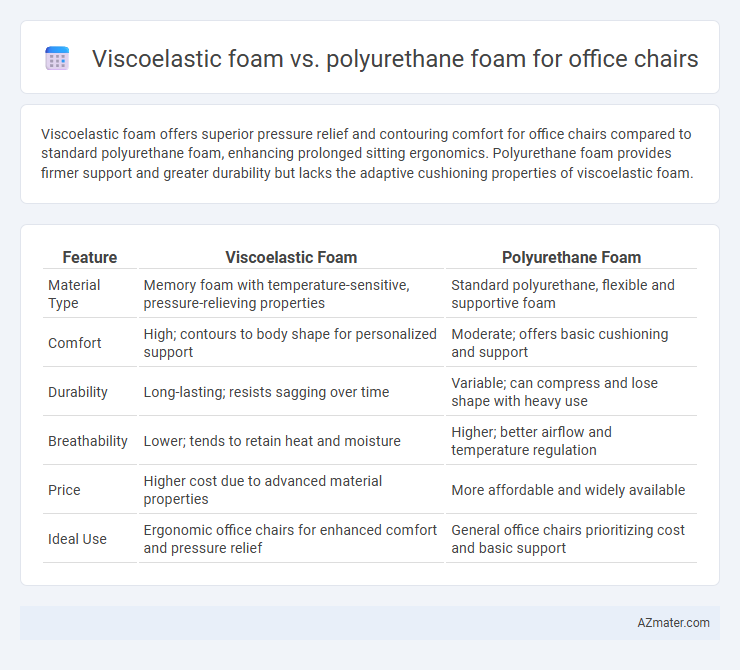Viscoelastic foam offers superior pressure relief and contouring comfort for office chairs compared to standard polyurethane foam, enhancing prolonged sitting ergonomics. Polyurethane foam provides firmer support and greater durability but lacks the adaptive cushioning properties of viscoelastic foam.
Table of Comparison
| Feature | Viscoelastic Foam | Polyurethane Foam |
|---|---|---|
| Material Type | Memory foam with temperature-sensitive, pressure-relieving properties | Standard polyurethane, flexible and supportive foam |
| Comfort | High; contours to body shape for personalized support | Moderate; offers basic cushioning and support |
| Durability | Long-lasting; resists sagging over time | Variable; can compress and lose shape with heavy use |
| Breathability | Lower; tends to retain heat and moisture | Higher; better airflow and temperature regulation |
| Price | Higher cost due to advanced material properties | More affordable and widely available |
| Ideal Use | Ergonomic office chairs for enhanced comfort and pressure relief | General office chairs prioritizing cost and basic support |
Introduction: Viscoelastic Foam vs Polyurethane Foam
Viscoelastic foam, commonly known as memory foam, offers superior pressure relief and contouring by responding to body heat and weight, making it ideal for prolonged office chair use. Polyurethane foam provides a firmer support structure with quicker recovery time, offering durability and cost-effectiveness for office seating applications. Comparing these materials highlights viscoelastic foam's comfort advantages against polyurethane foam's resilience and budget-friendly characteristics.
Defining Viscoelastic Foam: Properties and Benefits
Viscoelastic foam, also known as memory foam, is a temperature-sensitive material that conforms to body shape, providing personalized support and pressure relief, making it ideal for office chairs aimed at enhancing ergonomic comfort. Its high density and open-cell structure improve durability and breathability compared to traditional polyurethane foam, which tends to be less adaptive and more prone to flattening over time. This foam's viscoelastic properties absorb shocks and reduce stress on pressure points, promoting better posture and reducing fatigue during extended periods of sitting.
Understanding Polyurethane Foam: Features and Uses
Polyurethane foam is a versatile material widely used in office chair cushions due to its durability, lightweight nature, and cost-effectiveness. It offers a range of firmness levels, providing essential support to maintain ergonomic posture during extended sitting periods. Unlike viscoelastic foam, polyurethane foam responds quickly to pressure, making it ideal for dynamic seating environments that require frequent movement.
Comfort and Ergonomics: Side-by-Side Comparison
Viscoelastic foam, often known as memory foam, conforms closely to body contours, providing superior pressure relief and enhanced ergonomic support by evenly distributing weight and reducing strain. Polyurethane foam typically offers firmer support with quicker recovery, making it less adaptive but more resilient for prolonged use without significant deformation. For office chairs, viscoelastic foam excels in comfort by minimizing pressure points during long sitting periods, while polyurethane foam prioritizes durability and structural integrity in ergonomic design.
Pressure Relief Capabilities: Which Foam Performs Better?
Viscoelastic foam, commonly known as memory foam, offers superior pressure relief by conforming closely to the body's contours, distributing weight evenly and reducing pressure points compared to traditional polyurethane foam. Polyurethane foam tends to be firmer and less adaptive, which can result in increased discomfort during prolonged sitting due to uneven pressure distribution. Therefore, viscoelastic foam is generally preferred for office chair cushions where enhanced pressure relief and ergonomic support are critical for user comfort.
Durability and Longevity in Office Chair Applications
Viscoelastic foam offers superior durability and longevity for office chairs due to its high density and ability to retain shape under constant pressure, reducing wear over time. Polyurethane foam, while more affordable, tends to compress and degrade faster, leading to less support and a shorter lifespan in high-use office environments. Office chairs with viscoelastic foam typically provide longer-lasting comfort and structural integrity, making them a preferred choice for extended daily use.
Breathability and Temperature Regulation
Viscoelastic foam offers superior breathability and temperature regulation due to its open-cell structure, which allows better air circulation and reduces heat retention, making it ideal for prolonged office chair use. Polyurethane foam tends to trap heat because of its denser, closed-cell design, which can lead to discomfort during extended sitting periods. Incorporating viscoelastic foam in office chairs enhances user comfort by maintaining cooler surface temperatures and providing effective moisture management.
Cost Analysis: Value for Money
Viscoelastic foam typically costs 30-50% more than standard polyurethane foam but offers superior pressure relief and durability, enhancing long-term comfort and reducing the need for frequent replacements. Polyurethane foam provides a budget-friendly option with decent support but tends to degrade faster, leading to higher cumulative costs over time. Evaluating the balance between initial investment and lifespan, viscoelastic foam delivers better value for money in office chair applications where ergonomic support is critical.
User Experience: Feedback and Reviews
Viscoelastic foam, commonly known as memory foam, is praised by office chair users for its superior contouring and pressure relief, enhancing comfort during long work hours. Polyurethane foam, while less adaptive, offers firmer support and durability, often favored by users seeking a balanced feel with quicker response times. User feedback highlights memory foam's ability to reduce discomfort and improve posture, whereas polyurethane foam is appreciated for maintaining shape and providing consistent support over time.
Conclusion: Choosing the Best Foam for Office Chairs
Viscoelastic foam offers superior pressure relief and contouring by responding to body heat and weight, making it ideal for long hours of office sitting. Polyurethane foam provides greater durability and firmer support, often at a lower cost, suiting those who prefer a more structured seating experience. Selecting the best foam depends on individual comfort preferences and budget, with viscoelastic foam excelling in ergonomic comfort and polyurethane foam favoring resilience and affordability.

Infographic: Viscoelastic foam vs Polyurethane foam for Office chair
 azmater.com
azmater.com